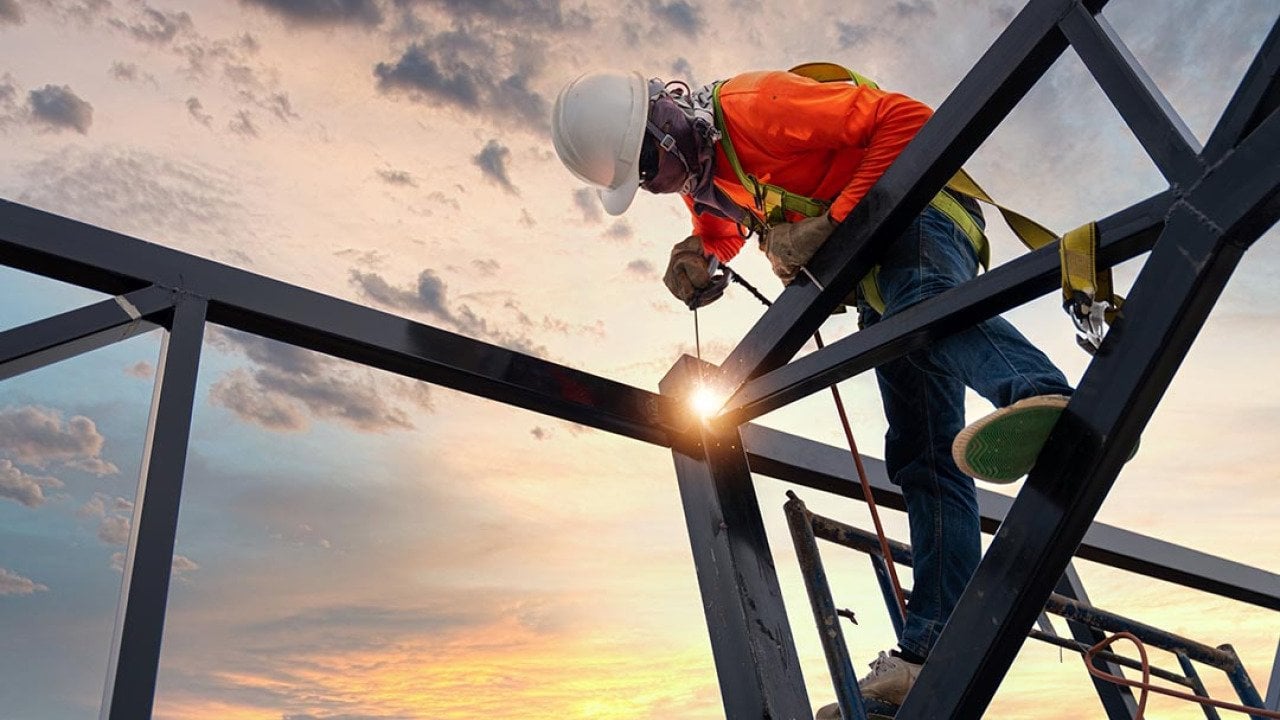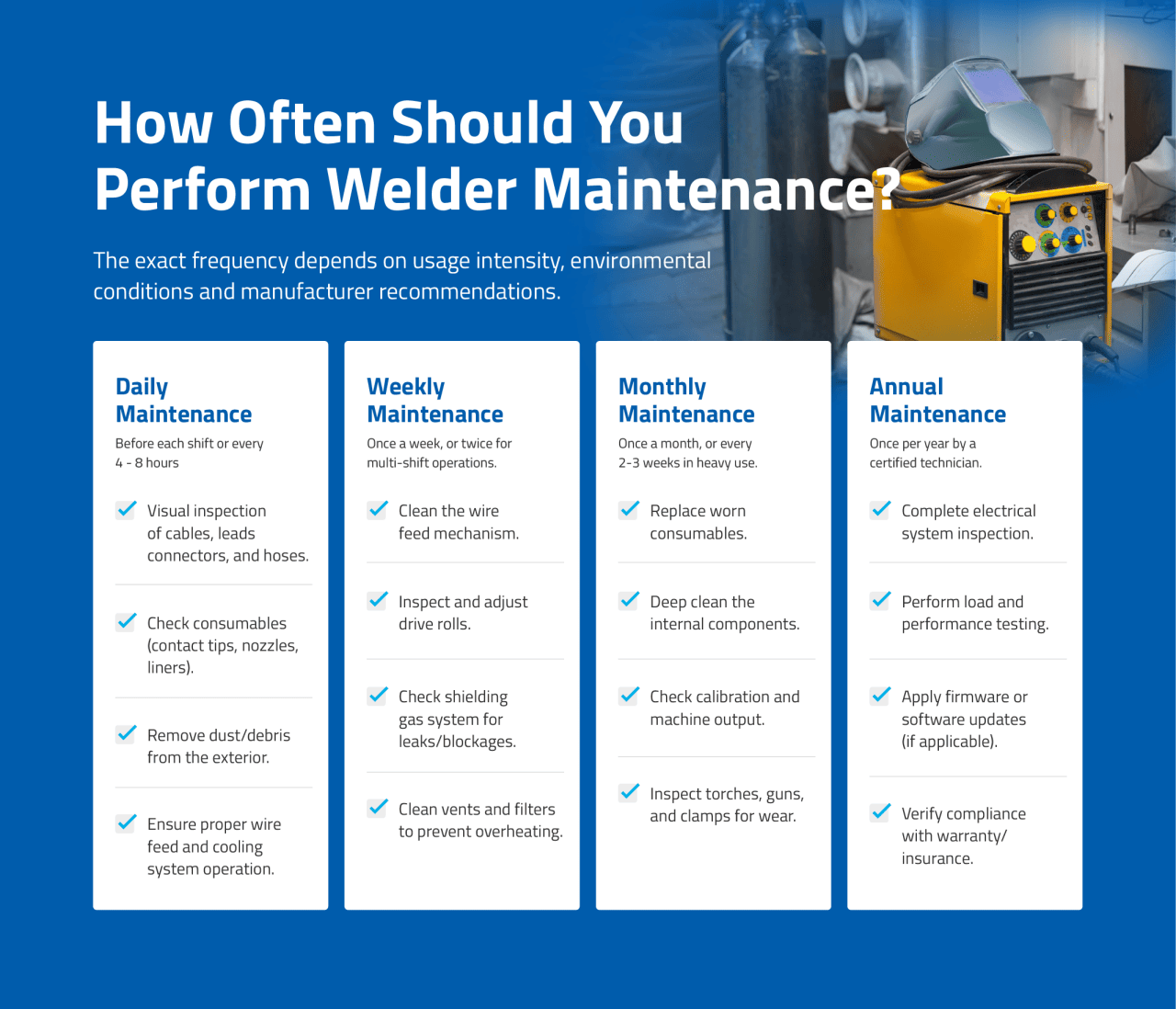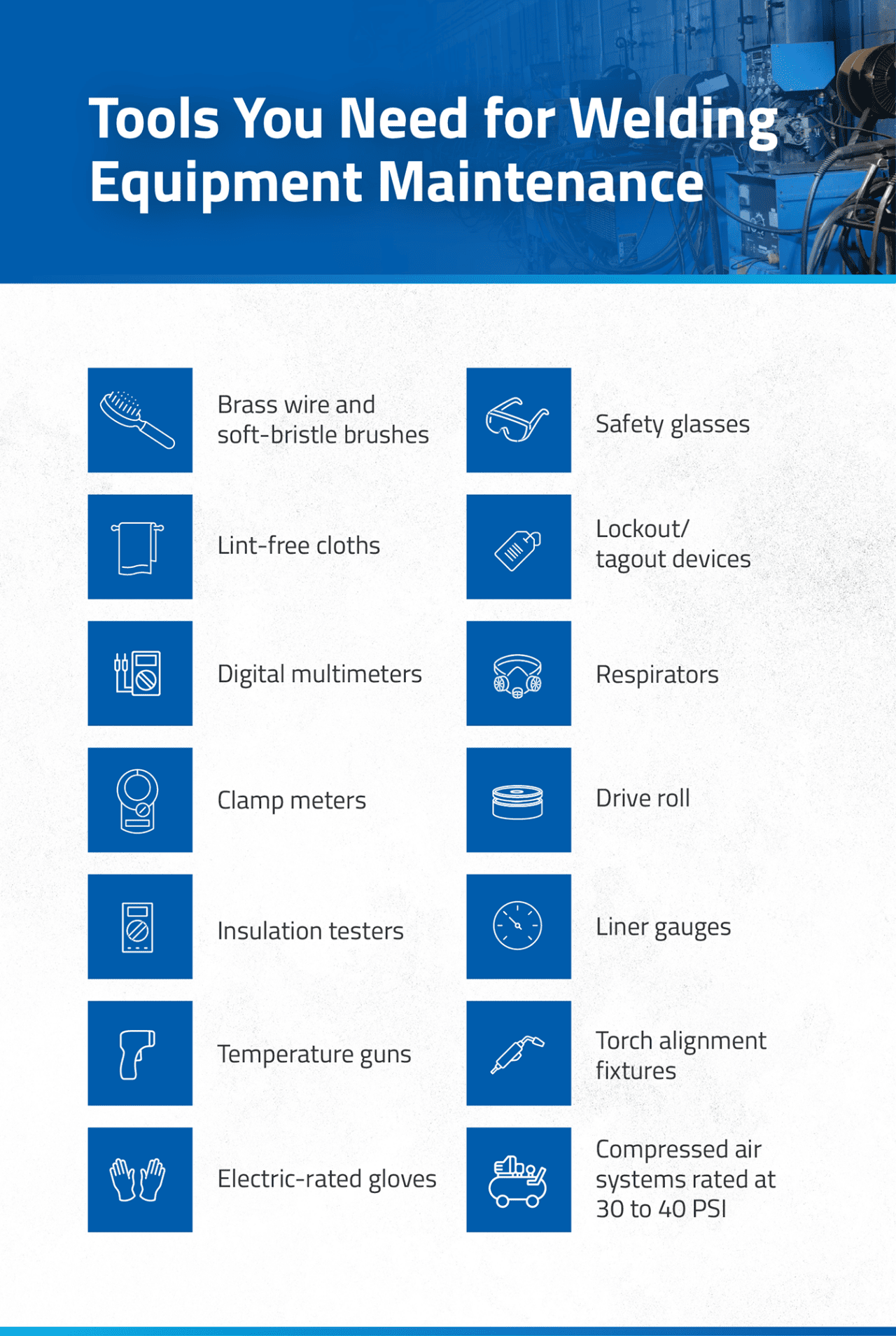How do you maintain a welder?

Tong_stocker // Shutterstock
How do you maintain a welder?
To remain fully functional, a welder requires regular cleaning, inspection and replacement of consumable parts, following regular maintenance schedules. Proper welder maintenance ensures safe operation and consistent weld quality while reducing downtime and repair costs.
Routine maintenance of welding equipment is the most critical yet often overlooked aspect of welding operations. Whether you operate a small fabrication shop or manage industrial welding operations, welder maintenance impacts your bottom line, worker safety and product quality.
This expert guide by Meritus Gas explains how to maintain a welder and provides comprehensive maintenance strategies for all major welder types.
Why Should You Maintain Welding Equipment?
Regular welder maintenance prevents unexpected failures that can cause workplace accidents, production delays and costly emergency repairs.
1. Enhanced Safety
According to the Occupational Safety and Health Administration (OSHA), electrical hazards account for a significant percentage of welding-related injuries. Poorly maintained equipment increases risks of electrical shock, burns from faulty connections and exposure to harmful fumes due to inadequate ventilation systems. Routine inspection and maintenance of electrical components, cables and safety features reduces these hazards.
2. Increased Efficiency and Performance
Properly maintained welding equipment can operate more efficiently than neglected machines, ensuring high performance. Well-maintained welders deliver consistent arc stability, proper heat control and reliable wire feed rates, which ensure uniform weld quality and reduce rework rates.
3. Cost Efficiency
Cost savings manifest in multiple ways through preventive maintenance. While regular maintenance requires time and resources, it prevents catastrophic failures that often cost significantly more than preventive measures. Additionally, well-maintained equipment experiences less downtime, maintains resale value and operates more efficiently, reducing energy consumption.
Compliance with industry standards and regulations requires documented maintenance procedures. Manufacturer warranties, ANSI Z49.1 safety standards and insurance requirements all mandate regular equipment maintenance. Failure to maintain proper documentation can void your warranty, increase insurance premiums and cause potential legal liabilities.
How Often Should You Perform Welder Maintenance?
You should perform welder maintenance according to a structured schedule, including daily visual inspections, weekly cleaning and adjustment tasks, monthly comprehensive checks, and annual professional servicing. The exact frequency depends on usage intensity, environmental conditions and manufacturer recommendations.

Meritus Gas Partners
- Daily: These tasks focus on visual inspection and basic cleaning before each shift. Operators should inspect cables, connections and consumables. This inspection takes approximately 10 to 15 minutes and helps you avoid common issues. High-production environments may require inspection after every four to eight hours of use.
- Weekly: These tasks involve more thorough cleaning and component checks. Weekly maintenance includes cleaning wire feed mechanisms, inspecting drive rolls and checking gas delivery systems. Shops operating single shifts typically perform these tasks every Friday, while multishift operations may require twice-weekly maintenance.
- Monthly: Replace consumables and perform comprehensive system checks monthly. Monthly tasks also include deep cleaning, calibration checks and replacing worn components. Heavy industrial users often perform these tasks every two to three weeks, while light-duty users can extend them to six to eight weeks.
- Annual: Your welder requires professional inspection and servicing at least once a year. Certified technicians should inspect electrical systems, perform load testing and update control software. This schedule aligns with most manufacturer warranty requirements and insurance policy stipulations.
Environmental factors impact maintenance frequency. Dusty conditions require frequent filter cleaning and vent maintenance, while humid environments necessitate additional corrosion prevention measures. Outdoor operations demand increased attention to weather protection and cable integrity.
What Tools and Supplies Do You Need?
Essential tools for welder maintenance include cleaning tools, electric testing equipment, appropriate personal protective equipment (PPE) and proper cleaning agents. Having the right tools ensures safe, effective maintenance procedures.

Meritus Gas Partners
Here’s a list of the tools you may need for welding equipment maintenance:
- Brass wire and soft-bristle brushes
- Lint-free cloths
- Digital multimeters
- Clamp meters
- Insulation testers
- Temperature guns
- Electric-rated gloves
- Safety glasses
- Lockout/tagout devices
- Respirators
- Drive roll
- Liner gauges
- Torch alignment fixtures
- Compressed air systems rated at 30 to 40 PSI
You should also keep replacement parts for common consumables such as contact tips, nozzles, diffusers and linear assemblies on hand.
How Do You Prepare a Welder for Maintenance?
To prepare your welder for maintenance, follow a systematic shutdown procedure that includes powering down, disconnecting power sources, cooling time and securing the work area.
- Shut down sequence: Power down the welder using proper controls and allow cooling fans to complete their cycles to prevent thermal shock to internal components and ensure safe handling temperatures.
- Disconnect: Turn off the main power switch on the welder, shut off the circuit breaker at the electrical panel and unplug the welder from its power source when possible. For hardwired units, implement lockout/tagout procedures according to OSHA 1910.147 standards.
- Secure the area: Clear combustible materials within a 35-foot radius, provide adequate lighting for detailed inspection, and set up barriers or warning signs to prevent unauthorized access.
- Review documentation: For specific maintenance requirements and safety warnings, consult your equipment manuals. Reviewing maintenance history logs can help you identify recurring issues.
How Do You Maintain Welding Equipment?
To properly maintain welding equipment, implement systematic daily, weekly and monthly tasks that address different components and wear patterns. Each maintenance level builds upon the previous, creating a comprehensive care program that maximizes equipment reliability and performance.
The maintenance hierarchy helps prioritize tasks effectively. Daily tasks prevent immediate failures and safety hazards while weekly maintenance addresses normal wear patterns before impacting performance. Monthly procedures reset equipment to optimal operating conditions. This layered approach ensures all critical components receive adequate attention.
Daily Welder Maintenance Checklist
Daily maintenance tasks are fundamental to equipment reliability. This welder maintenance checklist takes 10 to 15 minutes but prevents the most common welding failures.
- Inspect cables and connections: Damaged cables cause arc instability, increase electrical resistance and create safety hazards. Examine the entire length of welding cables for cuts, burns or exposed conductors. Ensure connection points are tight, and check them for corrosion or heat damage.
- Clean the exterior and vents: Use compressed air to blow out intake and exhaust vents, working from inside out. Accumulated dust and debris reduce cooling efficiency, leading to premature component failure and unexpected shutdowns.
- Check for gas leaks: Apply a leak detection solution to connections, regulators and hose fittings. Small leaks waste expensive shielding gas and compromise weld quality through inadequate coverage. Document and repair detected leaks before returning equipment to service.
- Ensure proper grounding: Ground resistance should meet manufacturer specifications. Check ground clamp condition and cable connections, and measure ground circuit resistance using appropriate test equipment. Poor grounding causes arc instability, increases spatter and creates electrical shock hazards.
- Verify settings and controls: Test switches, knobs and digital controls for smooth operation. Verify meter accuracy against known standards, and check that voltage and wire speed settings remain stable during operation. Erratic controls are a sign of internal component wear that requires professional service.
In-Depth Welding Equipment Maintenance
Weekly and monthly maintenance addresses component wear and contamination that daily inspections cannot prevent. These procedures typically take 30 to 60 minutes but extend equipment life significantly.
- Inspect and clean wire feeders and drive rolls: Remove drive rolls and clean with appropriate solvents to remove metal particles. Using manufacturer gauges, inspect roll grooves for wear. Worn grooves cause wire slippage, bird nesting and erratic arc characteristics. Replace rolls showing measurable wear and groove deformation.
- Check and replace consumables: Worn consumables increase operating cost through rework and reduced disposition efficiency. Replace contact tips when orifices show oval wear or excessive spatter buildup. If the spatter resists cleaning or orifice damage appears, install new nozzles. Change diffusers showing erosion or thread damage.
- Lubricate moving parts: To minimize mechanical wear in moving components, apply manufacturer-specified lubricants to wire drive gearboxes, boom pivot points and cartwheels.
- Inspect hoses and regulators: Examine gas hoses for racing near connection points. Test regulator operation through the whole pressure range and check flowmeter accuracy using calibrated equipment. Replace components showing wear before complete failure.
- Test safety features: Monitor shutdown temperatures and verify ground fault protection using appropriate procedures. Check emergency stops from all control locations, documenting safety systems tests for compliance requirements.
How Do You Maintain the Power Source and Electrical Components?
You maintain power sources and electrical components through systematic cleaning, connection inspection and performance testing while following strict electrical safety procedures. These components require careful attention to prevent costly failures.
Electrical safety is critical during power source maintenance. Before opening electrical enclosures, you must verify complete de-energization using approved test equipment. When working inside larger power sources, use rated insulated tools and follow confined space procedures.
Here are three crucial steps to maintain the power source and electrical components:
- Internal cleaning: Use dry compressed air to remove dust from heat sinks, transformers and circuit boards. Direct airflow away from sensitive components. For stubborn contamination, use approved electrical contact cleaners following the manufacturer’s guidelines.
- Inspect connections: Use calibrated torque wrenches to check power connections for tightness. Look for discoloration that indicates overheating and examine wire insulation for cracking. Loose connections generate heat, waste energy and cause connection failure.
- Test output: Use calibrated load banks to test voltage and current at multiple settings and compare readings to manufacturer specifications. Output testing verifies power source operation across its full range.
You should also maintain the cooling system to prevent buildup that causes power source failure. Clean or replace intake filters monthly in a typical environment and weekly in dusty conditions. Verify fan operation and check for bearing noise. Monitor internal temperatures during operation to identify cooling degradation before damage occurs.
What Are the Best Practices for Caring for Welding Cables and Leads?
Another crucial aspect of welder maintenance is caring for welding cables and leads through damage inspection, proper storage, and systematic repair and replacement. Proper cable maintenance prevents production interruptions and reduces electrical hazards.
Correct storage protects cables from UV exposure, chemicals and temperature extremes, ensuring longevity. Coil cables in large loops, avoiding sharp bends that stress conductors. Hang cables on appropriate racks to prevent contact with the floor.
The proper cleaning procedures remove conductive contaminants that create safety hazards and reduce electrical leakage. To remove metal particles and fumes, wipe cables with appropriate solutions. Focus on connection points where contamination accumulates.
Before use, run cables through your hands to feel for soft spots indicating internal conductor damage. Look for cuts, burns or worn insulation areas, and check lug connections for corrosion or looseness.
For any damaged areas, use approved cable repair tape for minor insulation cuts and apply heat-shrink tubing over worn areas. Using proper crimping tools, replace damaged lugs. Replace the welding cables if you notice conductor damage or extensive insulation deterioration.
How Should You Maintain Gas Delivery Systems?
Gas delivery systems require attention due to high-pressure hazards and contamination sensitivity. Small leaks waste significant gas volumes while contamination causes porosity and weld defects. Systematic maintenance through leak testing, component cleaning and regular flow verification prevents these issues.
- Leak testing: Electronic leak detectors provide increased sensitivity for small leaks that visual methods may miss. If you don’t have an electronic detector, apply leak detection solutions to all fittings to ensure no leaks. Test at maximum system pressure to identify marginal connections.
- Filter maintenance: Replace the inline filters according to manufacturer schedules or when a pressure drop shows clogging. Clean reusable filter elements with appropriate solvents. Contaminated filters restrict flow and introduce particles that cause weld defects.
- Cylinder storage and handling: Store cylinders upright with protective caps installed, secure them with chains to prevent tip-over, and segment cylinder types to prevent gas mixing. Follow the Compressed Gas Association (CGA) and OSHA Standard 1910.253 guidelines for safe handling and storage.
- Flow verification: Use calibrated flowmeters to verify actual rates versus the indicated ones. Test flow at the torch using measurement devices, adjust regulator settings to compensate for pressure drops, and document flow rates for quality control.
How Can You Troubleshoot Common Welder Maintenance Issues?
Common maintenance issues include inconsistent arc, overheating and wire feed issues. They often stem from inadequate maintenance rather than component failure. Systematic troubleshooting helps prevent or immediately correct regular maintenance issues.
Record when problems occur, conditions present and associated symptoms. This information guides logical troubleshooting and prevents random parts replacement. Use manufacturer troubleshooting guides for systematic diagnostic procedures.
Testing procedures isolate problems to specific components. Use appropriate test equipment to verify electrical values and gas flows, and compare measurements to specifications to identify out-of-tolerance conditions.
Electronic control problems, transformer failures and complex mechanical issues require specialized knowledge and tools. If you identify any of these complex internal failures, consult a professional or the manufacturer. Attempting repairs risks additional damage and safety hazards.
Maintaining Welder Excellence Through Systematic Care
Regular welder maintenance is an investment that improves safety, increases productivity and extends equipment life. Creating customized checklists adapted to your equipment and conditions and performing maintenance consistently ensures your welding equipment serves you for a long time.
Implementing the structured procedures in this guide can help welding operations achieve optimal equipment performance while meeting safety and regulatory requirements.
This story was produced by Meritus Gas Partners and reviewed and distributed by Stacker.
![]()
